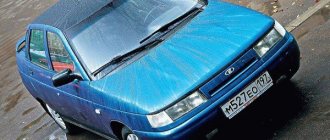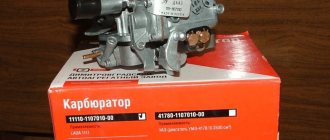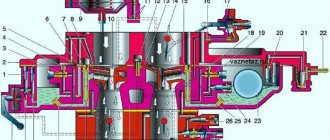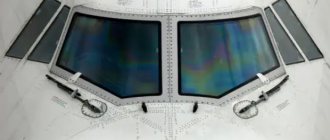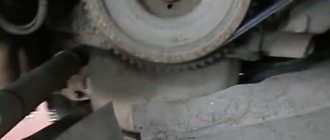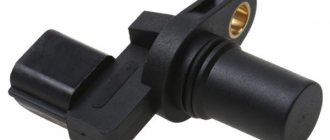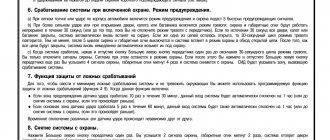Collection of technological instructions Lada Largus, Largus FL
The article presents manuals for maintenance and repair of the Lada Largus car. The collection of instructions is intended for specialists and engineering workers of enterprises involved in the sale, maintenance and repair of LADA cars, and can be used in personnel training.
The collection includes technological instructions that outline the technological sequence of work on diagnostics, maintenance, removal, installation and repair of components and parts of the engine, transmission, chassis, brakes, electrical equipment, attached body parts and interior. Data is provided on adjustment parameters, tightening torques, operating materials used, as well as equipment and special tools.
Resetting trip mileage counters and other parameters to zero
To reset the trip mileage counter No. 1, use the “Up” and “Down” buttons on the right steering column lever to select mode B “Trip mileage counter No. 1” in the on-board computer menu and press any of the “Up” or “Down” scrolling buttons ", hold it for a while. The selected value will first flash and then reset to zero.
Resetting the trip mileage counter No. 2 is possible only together with resetting a group of other on-board computer readings: – C “Total fuel consumption”; – D “Average fuel consumption”; – G “Trip mileage counter No. 2”; – H “Average speed”.
That is, when one of these readings is reset, the entire group is reset to zero. To reset a group of these readings, use the “Up” and “Down” buttons on the right steering column lever to select any of the modes C, D, G, H in the on-board computer menu and, by pressing any of the “Up” or “Down” scrolling buttons, hold it for a while. The selected value will first begin to flash, and then all four readings in the group will be reset to zero.
In addition, if the maximum value of the trip counters is exceeded, the parameters are reset automatically.
Lada Largus until 2022
The technology was developed taking into account the design of the car as of 02/01/2012. If the design changes, changes may be made to the technology.
Documentation in electronic form can be downloaded in PDF format by all site users:
- TI 3100.25100.10035: Hub with brake disc assembly for front-wheel drive LADA cars - runout measurement on the car. Available at this link.
- TI 3100.25100.27061: Modification of intake module 21127-1008600 for installation on Lada Vesta CNG and Lada Largus CNG cars with gas equipment. Available at this link.
- TI 3100.25100.27059: Additional equipment for LADA vehicles. Towing coupling device - installation. Available at this link.
- TI 203100.25100.12045 Diagnostics of the electronic anti-theft immobilizer system for the Lada Largus car
- TI 3100.25100.87020 LADA cars – anti-corrosion treatment of closed cavities, underbody and wheel arches. Link
- TI 3100.25100.13070 LADA cars - checking and adjusting wheel alignment angles. Link
- TI 3100.25100.40209 External rear view mirror of Lada Vesta, Largus FL – disassembly / assembly. Link1, Link2, Link3
- How to disassemble the rear bumper
- Diagnostics of the electronic engine management system of the H4M E5 engine with an EMS3125 controller and the K4M E5 engine with an EMS3120 controller (link below)
To download files you need to log in to the site.
OVAL RACING
The first acquaintance is casual, on the high-speed road of the AvtoVAZ test site. The sixteen-valve engine drives boringly, without a spark: no pick-ups, no dips. But how convenient it is with him! If you don’t drop the speed below 50 km/h, you don’t have to shift at all - it confidently accelerates a one and a half ton car in fifth gear from an engine speed of just over a thousand up to the declared maximum speed. By the way, we checked it using a GPS navigator. In the wind, "Largus" accelerated to 180, and in the other direction it only reached 161 km/h. Why is there such a big difference? Take a look at the serious dimensions of the station wagon - the front projection area is 2.38 m². And also the aerodynamic drag coefficient is hardly better than that of brick (Cx = 0.42; comparable to that of a Zhiguli). Obviously, the incoming air seriously slows down this low-flying “suitcase”.
When the speedometer needle goes well beyond a hundred, driving the Largus becomes uncomfortable: a side wind knocks it off course, and the light and sensitive steering wheel prevents it from clearly returning to the true path. After a few laps you get used to it, but the pleasure of driving disappears.
I drop to cruising speeds and listen to extraneous noises. After three laps, I still didn’t hear “crickets” under the instrument panel, the upholstery didn’t creak anywhere, and the rear seat backs didn’t move around in the locks. Unusual and atypical for cars topped with a rook.
download in PDF format
Auto repair manual for VAZ Lada Largus in electronic form. The manual will always be at hand during car maintenance and repair; to do this, just download it for free to your tablet or phone in pdf format.
Before using the car manual, check the year of manufacture and engine of the car.
Russian language
Format: pdf
File size: 44.8 Mb
e-book in pdf format
Please remember that your vehicle may not include all the features described in the manual. The repair manual may contain discrepancies with the description of your specific vehicle, and you may also find descriptions of options and equipment that are not on your vehicle.
To download the VAZ Lada Largus repair book, you need to follow the Download link, confirm that you have read the terms of use and download the file to your device. We do not limit download speed. If you have any difficulties, use the feedback form. We will try to resolve the problem and respond to you as quickly as possible.
What will you find in the VAZ Lada Largus repair book?
Detailed information about the device of the car.
An algorithm for identifying faults, a system of daily and periodic checks, reference information on self-diagnosis of the VAZ Lada Largus.
Instructions for timely vehicle maintenance.
Step-by-step guide for self-repair of VAZ Lada Largus.
Setting the clock on the BC display
Setting the clock on the BC display (optional).
By briefly pressing any of the “Up” and “Down” buttons on the right steering column lever, go to mode L for displaying the current time on the on-board computer display.
When you press and hold any of the “Up” or “Down” buttons for more than 3 seconds, the clock goes into time correction mode, and the hour digits begin to blink (the minute digits do not blink). A single and short press on the “Up” or “Down” button will change the readings by one hour. By pressing and holding the Up or Down button for a long time, the hour values rapidly change to the desired current reading.
If, after adjusting the clock, you do not press the buttons for 5 seconds, the clock will automatically switch to the minute correction mode, and the minute digits will begin to blink (the hour digits will not blink). A single and short press on the “Up” or “Down” button will change the readings by one minute. When you press and hold the Up or Down button for a long time, the minute values quickly change to the desired current reading.
If, after adjusting the minutes, you do not press the buttons for 5 seconds, the watch will automatically switch from the correction mode to the current time display mode.
Description of the book
Repair book for VAZ Lada Largus
Operation of any VAZ Lada Largus car is impossible without knowledge of its structure, maintenance and repair features. It doesn’t matter who will carry out the necessary work - every driver is simply obliged to know the basic maintenance and troubleshooting procedures.
The VAZ Lada Largus repair book contains all the necessary information that will help the owner understand the structure of the car, teach how to properly care for the car, timely maintenance and proper repairs.
The repair manual for the VAZ Lada Largus is divided into chapters: Vehicle design (describes general information and vehicle registration data); Operating instructions (preparation for departure, recommendations for traffic safety); Malfunctions along the way (tips to help you in case of an unexpected breakdown on the road); Maintenance (detailed recommendations for all maintenance procedures); Repair instructions (engine, transmission, chassis, steering, brake system, and also includes assembly and disassembly work necessary during the repair process of the VAZ Lada Largus); Electrical equipment (detailed manual for diagnosing and troubleshooting, the main units are described separately and detailed electrical diagrams of the VAZ Lada Largus are given).
Any of the repair procedures for the VAZ Lada Largus is given according to the principle from simple to complex: from the simplest maintenance operations, adjustments, replacement of parts, to global repairs with assembly and disassembly work.
All materials in the book are based on specific experience gained in the process of complete disassembly and assembly of a VAZ Lada Largus by highly qualified auto mechanics.
Book “Lada Largus. Design, maintenance, repair" is necessary so that diagnostics and repairs of the VAZ Lada Largus can be done professionally and quickly, even by the owner of the car who still has little practical experience.
You can download the VAZ Lada Largus repair manual for free in pdf format . You just need to download it to your phone or tablet and you can use it in any situation on the road.
Source
Front and rear suspension of Lada Largus
The front suspension (Fig. 1) is independent, MacPherson strut type, with telescopic shock absorbers, coil springs, lower wishbones and a stabilizer bar. The main element of the front suspension is a telescopic shock absorber strut, which combines the functions of a telescopic element of the guide mechanism and a damping element for vertical vibrations of the wheel relative to the body. The shock absorber strut contains a coil spring, a compression buffer, a strut protective cover and an upper support. The load is transmitted to the vehicle body through the thrust bearing and the upper support. The shock absorber strut is connected to the lower suspension arm by a ball joint. The lower arms are attached to the car body using silent blocks. The torsion-type anti-roll bar, with rubber cushions installed on it, is connected to the car's subframe by two brackets, and to the lower suspension arms by bolts. Anti-roll bar is a device in the car suspension that serves to reduce lateral roll when turning the car. The main element of the stabilizer is the rod, which is a torsion bar (a shaft that exerts torsion and acts as an elastic element). The rod is made of heat-treated steel, allowing high torsional stresses and significant twist angles (tens of degrees). The front wheel hubs are mounted on double-row angular contact ball bearings.
Fig.1 Front suspension Lada Largus 1 - subframe; 2 — rear silent block of the lever; 3 — front silent block of the lever; 4 — bracket for fastening the stabilizer bar; 7 — brake caliper; 6 — shock absorber strut; 5 - spring; 8 — front suspension arm; E — steering knuckle; 10 — bolt securing the anti-roll bar; 11 — anti-roll bar
The rear suspension is semi-independent, lever-spring with trailing arms 1 (Fig. 2), hinged to the car body and interconnected by a transverse beam 4 of U-shaped section. A non-removable torsion-type anti-roll bar is installed in the beam. The trailing arms are connected to the body by silent blocks. Suspension springs 3 are cylindrical. The upper and lower ends of the springs rest on elastic rubber pads. The lower ends of the double-acting telescopic hydraulic shock absorbers 2 are secured to the suspension arms with bolts 6. The upper ends of the shock absorbers are attached to the body through rubber pads. Each rear wheel hub is mounted on a double row ball bearing. The rear wheel alignment angles are specified by design and are not adjustable in operation. It is only possible to monitor the condition of the rear suspension at these angles. If the measured angles do not correspond to the control values, check the condition of the rear suspension.
Fig.2 Rear suspension of Lada Largus 1 - trailing arm; 2 — shock absorber; 3 - spring; 4 - beam; 5 — brake pipe; b — bolt of the lower shock absorber mounting

